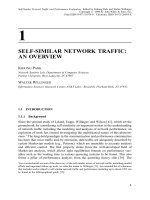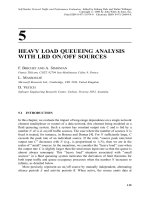Tài liệu Mạng lưới giao thông và đánh giá hiệu suất P3 pdf
Bạn đang xem bản rút gọn của tài liệu. Xem và tải ngay bản đầy đủ của tài liệu tại đây (214.38 KB, 12 trang )
3
SIMULATIONS WITH HEAVY-TAILED
WORKLOADS
M
ARK
E. C
ROVELLA
Department of Computer Science, Boston University, Boston, MA 02215
L
ESTER
L
IPSKY
Department of Computer Science and Engineering, University of Connecticut,
Storrs, CT 06268
3.1 INTRODUCTION
Recently the phenomenon of network traf®c self-similarity hasreceived signi®cant
attention in the networking community [10]. Asymptotic self-similarity refers to the
condition in which a time series's autocorrelation function declines like a power law,
leading to positive correlations among widely separated observations. Thus the fact
that network traf®c often shows self-similarity means that it shows noticeable bursts
at a wide range of time scalesÐtypically at least four or ®ve orders of magnitude. A
related observation is that ®le sizes in some systems have been shown to be well
described using distributions that are heavy-tailedÐdistributions whose tails follow
a power lawÐmeaning that ®le sizes also often span many orders of magnitude [3].
Heavy-tailed distributions behave quite differently from the distributions more
commonly used to describe characteristics of computing systems, such as the normal
distribution and the exponential distribution, which have tails that decline exponen-
tially (or faster). In contrast, because their tails decline relatively slowly, the
proabability of very large observations occurring when sampling random variables
that follow heavy-tailed distributions is nonnegligible. In fact, the distributions we
discuss in this chapter have in®nite variance, re¯ecting the extremely high variability
that they capture.
Self-Similar Network Traf®c and Performance Evaluation, Edited by Kihong Park and Walter Willinger
ISBN 0-471-31974-0 Copyright # 2000 by John Wiley & Sons, Inc.
89
Self-Similar Network Traf®c and Performance Evaluation, Edited by Kihong Park and Walter Willinger
Copyright # 2000 by John Wiley & Sons, Inc.
Print ISBN 0-471-31974-0 Electronic ISBN 0-471-20644-X
As a result, designers of computing and telecommunication systems are increas-
ingly interested in employing heavy-tailed distributions to generate workloads for
use in simulation. See, for example, Chapters 14 and 18 in this volume. However,
simulations employing such workloads may show unusual characteristics; in
particular, they may be much less stable than simulations with less variable
inputs. In this chapter we discuss the kind of instability that may be expected in
simulations with heavy-tailed inputs and show that they may exhibit two features:
®rst, they will be very slow to converge to steady state; and second, they will show
highly variable performance at steady state. To explain and quantify these observa-
tionswe rely on the theory of stable distributions [4, 15].
These problems are not unique to simulation of telecommunications systems,
arising also in risk and insurance modeling [2]. Solutions to certain aspects of these
problems have been proposed, drawing on rare event simulation and variance
reduction techniques[8, 14].
In general, however, many of the problems associated with the simulations using
heavy-tailed workloads seem quite dif®cult to solve. This chapter does not primarily
suggest solutions but rather draws attention to these problems, both to yield insight
for researchers using simulation and to suggest areas in which more research is
needed.
3.2 HEAVY-TAILED DISTRIBUTIONS
3.2.1 Background
Let X be a random variable with cdf FxPX x and complementary cdf (ccdf)
Fx1 À FxPX > x. We say here that a distribution Fx is heavy-tailed if
Fx$cx
Àa
; 0 < a < 2; 3:1
for some positive constant c, where ax$bx meanslim
x3I
ax=bx1. (We
note that more general de®nitionsof heavy tailsare common; see, for example,
Goldie and KluÈppelberg [6].) If Fx isheavy tailed then X shows very high
variability. In particular, X hasin®nite variance, and, if a 1; X hasin®nite mean.
Section 3.2.2 will explore the implicationsof in®nite momentsin practice; here we
note simply that if fX
i
; i 1; 2; ...g is a sequence of observations of X , then the
sample variance of fX
i
g asa function of i will tend to grow without limit, aswill the
sample mean if a 1.
The simplest heavy-tailed distribution is the Pareto distribution, which is power
law over itsentire range. The Pareto distribution haspmf
pxak
a
x
ÀaÀ1
; 0 < k x;
and cdf
FxPX x1 Àk=x
a
; 3:2
90
SIMULATIONS WITH HEAVY-TAILED WORKLOADS
in which the positive constant k represents the smallest possible value of the random
variable.
In practice, random variablesthat follow heavy-tailed distributionsare character-
ized as exhibiting many small observations mixed in with a few large observations.
In such data sets, most of the observations are small, but most of the contribution to
the sample mean or variance comes from the few large observations.
This effect can be seen in Fig. 3.1, which shows 10,000 synthetically generated
observations drawn from a Pareto distribution with a 1:2 and mean m 6. In Fig.
3.1(a) the scale allows all observations to be shown; in Fig. 3.1(b) the y axisis
expanded to show the region from 0 to 200. These ®gures show the characteristic,
visually striking behavior of heavy-tailed random variables. From plot (a) it is clear
that a few large observations are present, some on the order of hundreds to one
thousand; while from plot (b) it is clear that most observations are quite small,
typically on the order of tensor less.
800
600
1000
400
200
0
0 2000 4000 6000 8000 10000
0 2000 4000 6000 8000 10000
0
20
40
60
80
100
120
140
160
180
200
Fig. 3.1 Sample data from heavy-tailed distribution with a 1:2.
3.2 HEAVY-TAILED DISTRIBUTIONS
91
An example of the effect of this variability on sample statistics is shown in Fig.
3.2. This ®gure shows the running sample mean of the data points from Fig. 3.1, as
well as a level line showing the mean of the underlying distribution (6). Note that the
sample mean starts out well below the distributional mean, and that even after
10,000 observations it is not close in relative terms to the distributional mean.
3.2.2 Heavy Tails in Computing Systems
A number of recent studies have shown evidence indicating that aspects of
computing and telecommunication systems can show heavy-tailed distributions.
Measurements of computer network traf®c have shown that autocorrelations are
often related to heavy tails; this is the phenomenon of self-similarity [5, 10].
Measurements of ®le sizes in the Web [1, 3] and in I=O patterns[13] have shown
evidence that ®le sizes can show heavy-tailed distributions. In addition, the CPU
time demands of UNIX processes have also been shown to follow heavy-tailed
distributions [7, 9].
The presence of heavy-tailed distributions in measured data can be assessed in a
number of ways. The simplest is to plot the ccdf on log±log axes and visually inspect
the resulting curve for linearity over a wide range (several orders of magnitude). This
is based on Eq. (3.1), which can be recast as
lim
x3I
d log
Fx
d log x
Àa;
so that for large x, the ccdf of a heavy-tailed distribution should appear to be a
straight line on log±log axes with slope Àa.
An example empirical data set is shown in Fig. 3.3, which is taken from Crovella
and Bestavros [3]. This ®gure is the ccdf of ®le sizes transferred through the network
due to the Web, plotted on log±log axes. The ®gure shows that the ®le size
distribution appears to show power-law behavior over approximately three orders
of magnitude. The slope of the line ®t to the upper tail is approximately À1:2,
yielding
^
a % 1:2.
Fig. 3.2 Running mean of data from Fig. 3.1.
92
SIMULATIONS WITH HEAVY-TAILED WORKLOADS
3.3 STABILITY IN SYSTEMS WITH HEAVY-TAILED WORKLOADS
As heavy-tailed distributions are increasingly used to represent workload character-
istics of computing systems, researchers interested in simulating such systems are
beginning to use heavy-tailed inputs to simulations. For example, Paxson [12]
describes methods for generating self-similar time series for use in simulating
network traf®c and Park et al. [11] use heavy-tailed ®le sizes as inputs to a network
simulation. However, an important question arises: How stable are such simulations?
This can be broken down into two questions:
1. How long until such simulations reach steady state?
2. How variable is system performance at steady state?
In this section we will show that if simulation outputs are dependent on all the
momentsof the distribution F, then the answers to the above questions can be
surprising. Essentially, we show that such simulations can take a very long time to
reach steady state; and that such simulations can be much more variable at steady
state than is typical for traditional systems.
Note that some simulation statistics may not be affected directly by all the
momentsof the distribution F, and our conclusions do not necesssarily apply to
those cases. For example, the mean number of customers in an M =G=I queueing
system may not show unusual behavior even if the service time distribution F is
heavy tailed because that statistic only depends on the mean of F.
Since not all simulation statistics will be affected by heavy-tailed workloads, we
choose a simple statistic to show the generality of our observations: the sample mean
of the heavy-tailed inputs. Since our results apply to the sample mean of the input,
we expect that any system property that behaves like the sample mean should show
similar behavior. For example, assume we want to achieve steady state in a particular
simulation. This implies that the measured system utilization l
x (where l
À1
isthe
–1
0
–2
–3
–4
–5
–6
12345678
Fig. 3.3 Log±log complementary distribution of sizes of ®les transferred through the Web.
3.3 STABILITY IN SYSTEMS WITH HEAVY-TAILED WORKLOADS
93









